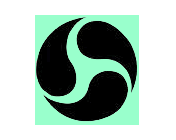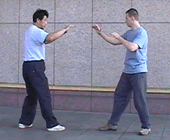

Baguazhang, Xiantian, Houtian and Daoist Philosophy
Gao style calls their core 64 straight line sets houtian. There are other straight line training drills/forms in Gao bagua that are not termed Houtian.
Xiantian and Houtian are two terms that come from the YiJing. They later became part of the everyday Chinese vernacular. Being part of the everyday Chinese vernacular and part of the Chinese philosophical world view in general, they were used to describe two concepts in Baguazhang. One being used to describe the desired type of innate movement, reactions, and body quality we seek (xiantian). The other being used to describe a more forced/deliberate process of accumulation of skills, strategies and whatnot (houtian). Many styles of Bagua will use these terms, but there might be small variations in how they are used within that branch. Each lineage, while claiming commonalities with all others, maintains their own "secrets," particularities, lingo, code words, training methods, etc.
All straight line sets in various bagua lineage are not termed houtian, although our particular lineage might look at the type of training that they do to be reminiscent of houtian type training. I know of no other bagua styles outside of Gao style that specifically use the term to refer to their straight line training in the same way.
The YiJing and Daoist philosophy are part and parcel of Chinese culture, they are inseparable. You may remember that before even I got married, I was required to submit the eight characters of my birth to the fortune teller so we could find an auspicious date for our marriage. This type of fortune telling is the basis of the YiJing and the base of Daoist mass religious practices for the last 2500+ years. Just like a Christian might pray at all times for guidance, a traditional Chinese might consult a fortune teller - and therefore the YiJing - at every step of their lives. All styles of Chinese martial arts use "classic" Chinese terminology. Terms like Wuji, taiji, liangyi, sanhe, sixiang, wuxing, liuhe, qixing, bagua, jiugong, etc. (non-Chinese speakers please note that I just basically counted from 0 to 9 in Chinese with an addendum to the end of each number signifying its relationship to a philosophical construct) are a constant throughout all styles of Chinese (even Asian) martial arts, and are also found throughout traditional Chinese culture in general. Looking into why they use those terms is not a mystical experience, its a task of looking into how the Chinese view the world and its relationships on their most basic level. Basic terminology that permeates traditional Chinese culture and basic conceptions of how the world is ordered - not magic.
FYI - another traditional method of classifying areas of martial arts practice or theory is the use of animal names. Different arts, or even the same arts, will use these in different manners depending on what they are trying to get across, what they are trying to teach.
In Bagua animal names are usually meant as some type of mental/emotional connection between the type and character of movement from a form or set of forms and a particular animal. The techniques will typically not try to imitate the percieved motions of a particular animal - they will imitate its spirit. So in our YiZong bagua they are later used in this context. I know in Liu Fengcai's bagua they also pass down 12 specific short straight line forms that each relate to an animal. Although I did learn them, I'm not the best person on this board though to comment on them. In other styles of Bagua they will also take this tact. Xie Peiqi's bagua is perhaps most famous for this - they use eight different animal names to each describe a certain style/manner/approach/strategy to movement, training and fighting. Sun Lutang's bagua is another, albeit more condensed, example of this.
There's probably way too much right now for me to attempt to go into all the possibilities of why Dong (or Cheng/Yin/Song/Ma/etc.) kept changing the name of the art. Brief possibilities: just wanted it to sound better/more palatable, wanted to relate it to something more ethereal/higher sounding, kept the name from the authorities (there was a rebellion that used the name Ba Gua a few decades earlier), the art itself was still in flux/development, etc.
As to how the association with Daoist philosophy has affected the art since its inception... that's also a lot to go into. At different periods it would have affected it in slightly different ways. In the early period (late Qing dynasty - roughly 1860 to 1911 (or maybe slightly longer)) it allowed for acceptance on a broader scale by the social elite, nobility, and scholars. That's where the money was. During the Republican period (Warlord period and KMT rule to liberation - roughly 1911 to 1949(again give or take a few years - these are just artifically imposed trends and observations by me after all)) I suspect it allowed for some relevance to how students would have already conceived of the world. Their living circumstances were changing so rapidly at the time that they needed a way to intellectually manage what they were learning and pass it on. In short, they needed a systematic way of teaching. Foreign teaching methods were beginning to be known. There was more exchange of information at the time. There was more travel and movement of peoples. There was more war and uncertainty. It was difficult at this time to sit in one place with a teacher and a group of fellow students and train well over a long period of time. After "liberation" in 1949 things are even more difficult to succinctly pin down. There were many different trends all fostering their own ends at the same time. The arts were being scattered beyond their birthplace (Taiwan, HongKong, America, Europe) and the former concentration of high-level players in Beijing and Tianjin were scattered as well. All martial arts training to be successful needs more than just a good teacher - it also needs a good system, a good student and then one of the most overlooked aspects is a good group of like-minded students/brothers to train with. Beyond that even, a larger peer group of similar-seeking individuals helps these days. The latter two limit stagnation and help one to understand the diversity of training one needs. In modern times the Daoist philosophical overlay to the system brings people who would be attracted to that sort of thing (this can be a detriment to the real art). It also provides us a connection to the past history of our ancestors in this art. It allows us a more direct look at their thought process when looking at the system as a whole. In physical practice it has led many people astray as they seek the leaves for the trees and the finger for the moon.
